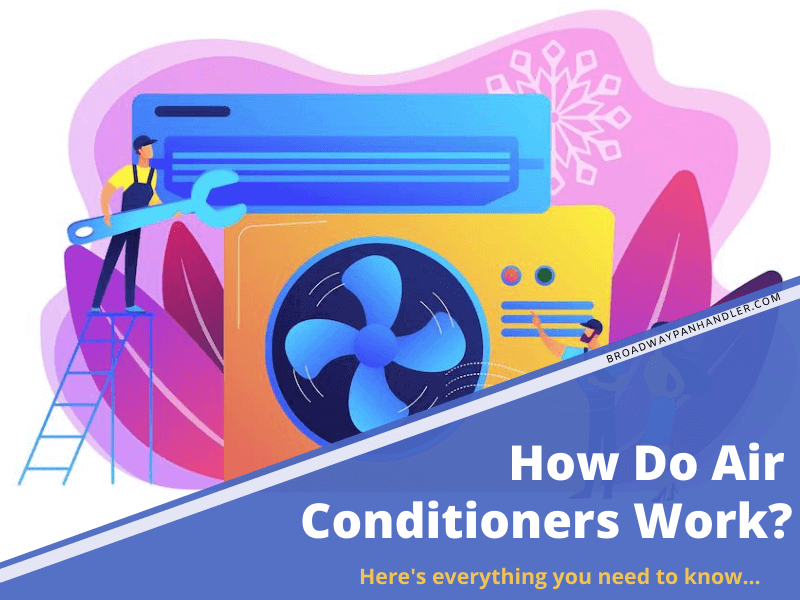If you live in a state which experiences extreme temperatures, then an air conditioner will be one of your important home gadgets which enhances your life and makes everything seem more comfortable and much more relaxing.
According to a published report by the Energy Information Administration, around 87% of homes across America uses an air conditioning unit, and the figure keeps increasing. From this report, we can see that the reliance on good air conditioning systems by homeowners to keep the maintain balanced home cooling has deeply penetrated modern life.
But before you start considering buying an air conditioner, how exactly does an air conditioner work to take out the heat and bring in cool air?
How Does Air Conditioners Work?
Air conditioners take heat and humidity out of the air inside your home via a cooling agent known as “refrigerant”, the heat is then distributed outside and a newly cooled air is returned back to the house. Air conditioners never take air from outside and put it in your home. Instead, AC’s work by cooling down the air that’s already in your home.
An air conditioner works through a basic concept which is based around a chemical called refrigerant, sometimes known as hydrochlorofluorocarbons or HCFCs. The refrigerant loops from inside your home, to outside your home on a continuous basis, banishing heat outside of your home. The refrigerant then cools as it enters your home and the process begins again.
The Air Conditioning Process Explained in Detail
When water is heated, the liquid evaporates into a water vapor or a gas. It is in this way that the refrigerant chemical works as it absorbs heat during its liquid state and then transforms into gas.
The refrigerant is then quickly turned back into a liquid, and the heat which it had previously absorbed is released outside. This cycle continues on a continuous loop.
Parts of the air conditioning system responsible for cooling your home
There are four parts to the air conditioning system namely:
- An evaporator
- A compressor
- A condenser
- An expansion device.
The evaporator is the part of the air conditioner which is found inside of the home, evaporating the refrigerant chemical. Air moves to the evaporator, the refrigerant located in the coil absorbs the heat from the air, turning the liquid to gas. As this process occurs and heat is taken from the air, the cold liquid turns to a hot vapor. The air is subsequently cooled down.
Once the refrigerant is vaporized, the gas visits the compressor section of the air conditioner, which is found outside of the home on the air conditioning unit.
The compressor compresses the gas to create a higher pressure and a higher temperature, passing this gas to the condenser.
The condenser condenses the gas back into the original liquid state and radiates the heat. The cooled liquid then returns into the home again.
The fourth part of the air conditioning system is the expansion device which then regulates the flow of liquid refrigerant into the evaporator, and the process begins all over again.
Benefits of using a home air conditioner
An air conditioning system is a fantastic tool to control the temperature within your home, cooling your family down when the hotter temperatures hit. However, there are additional benefits which your house can reap once you have fully installed an air conditioning system.
An air conditioner additionally reduces the humidity in the air, decreasing levels of water vapor in the air which helps your body feel cooler as sweating is reduced. This dehumidifying action enables the air to be drier as well as cooler, enhancing levels of comfort within your home.
Brief History
It is interesting to note that humidity control was actually the primary aim of the very first air conditioners, invented by Wills Carrier in Brooklyn, N.Y. in 1902. Temperature control was an additional benefit at the time for the air conditioner, which has ironically become the main selling point for modern air conditioning systems.
In fact, it was not until four years later in 1906 that the term ‘air conditioning’ was first used with the very first residential air conditioning system being installed in 1914. This air conditioning system was 7-feet high, 6-feet wide, and an enormous 20-feet long. Of course, this technology was only available to the wealthy in 1914, with air conditioning systems costing from $10,000 to $50,000, which would be the equivalent of paying between $120,000 to $600,000 today.
References and Resources
- Willis Carrier – The Inventor of Modern Air Conditioning – History information retrieved from carrier.com
- History of Air Conditioning – A Brief HVAC History information retrieved from coynecollege.edu
- Air conditioning – US Department of energy
